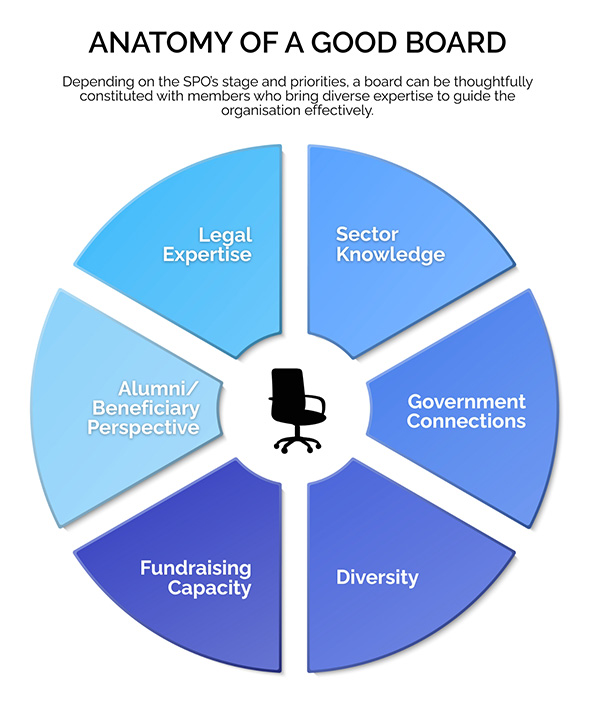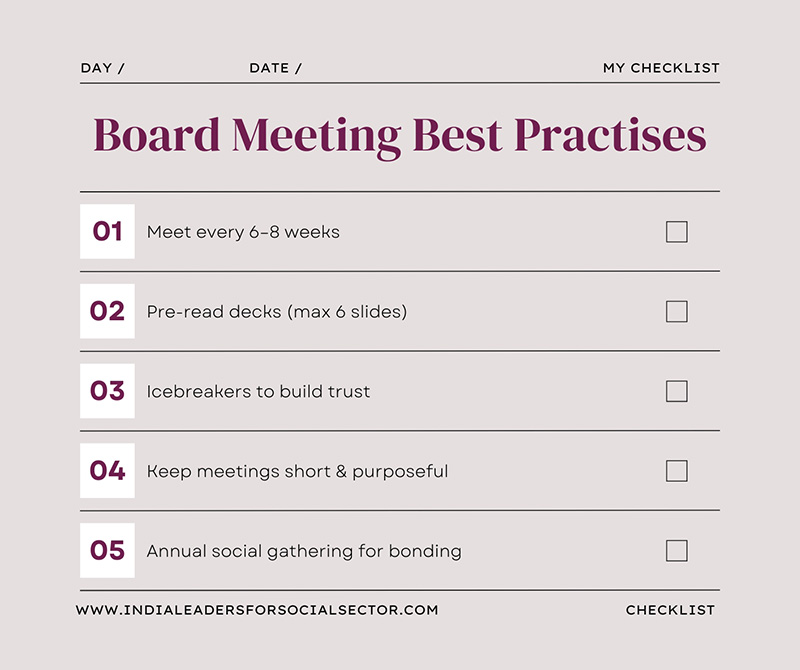Guest Column
Building Strong Advisory Boards:
Reflections from my Journey in the Social Sector
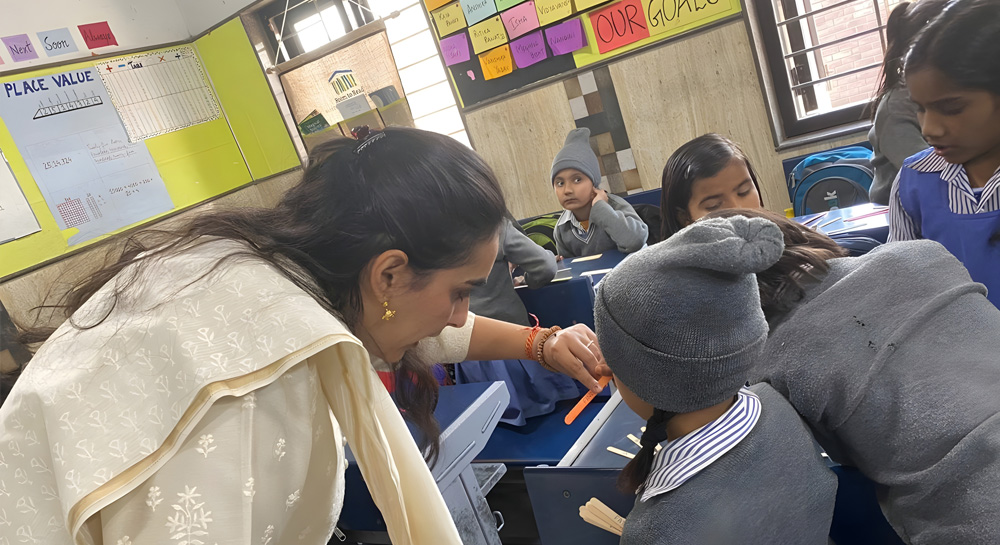
I’ve noticed that social purpose organisations (SPOs) wait until they are well into their operations or until a crisis emerges before thinking about governance.
Boards, at their best, exist to support the founder/CEO. Yet, too often I hear people talk about ‘managing’ their boards, as though they are juggling egos and emotions. Leaders need to set clear expectations that a board’s role is to support their success and not to create yet another layer of governance to ‘manage’. To me, that language already sets the wrong tone. A structured board should feel like a partnership that shows up regularly, spends time, and goes deep with the leader to guide the organisation forward.
Another thing to keep in mind is that boards are not static. They need to be revisited every few years as the organisation evolves. Every few years, it is worth reassessing and even revamping the board to ensure that the board’s composition reflects the organisation’s changing needs.
A pivotal part of creating a board is to identify the right board chairperson. The chair doesn’t need to be an expert in your sector, but they must believe passionately in your mission and have the organisational skills to keep the group on track. The relationship between the chair and the CEO is critical. It should be one of equality where both are able to challenge, support, and push each other.
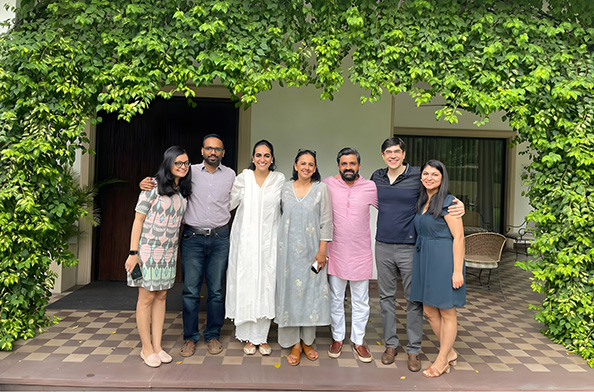
My own entry into this world was almost accidental. I had visited Teach For India (TFI) years earlier and had been inspired. But when I tried to organise a fundraiser for Teach for India, it failed. I felt disillusioned and decided that if I couldn’t give 100% to the sector while also running my business, I should step back. And so I did, for a few years.
Then, in 2018, Anu Aga (Former Chairperson, Thermax Limited and Nominated Member of Rajya Sabha (2012-18) and Trustee at Teach for India) called me. She needed someone to chair the Delhi board for TFI, which was struggling to manage its rapid growth. It felt like an urgent ask. I hesitated, but after meeting Anu and Aakanksha Gulati (CEO – ACT Grants who was the then Delhi City Director), I felt something shift within me. My love for creating order out of chaos, combined with my respect for Anu and the power of Aakanksha’s storytelling, pulled me in. I didn’t even fully understand TFI’s work at the time. I just knew I wanted to be part of it.
We formed the Delhi Regional Board in a very organic way. We needed legal expertise, so I brought in my friend, Akhil Sibal (Senior Advocate – Delhi High Court). We needed guidance on working with the government, and so we invited Amitav Virmani (Founder & CEO, The Education Alliance) for his rich experience at the intersection of education and government. Tarun Cherukuri (Founder-CEO, Indus Action) came in as an Alumni leader who had also previously been the City Director at Teach for India Delhi. And I had reached out to Anu Prasad (Founder & CEO, India Leaders for Social Sector) initially for recommendation of board members, and then when I urged her to be a part of our board, she joined too. Within a year, Aakanksha too transitioned from the city director to become a board member. There was no grand design, just thoughtful choices based on relationships and needs.
From the start, I emphasised renewal. I proposed that members, including myself, step down after two years. In the end, I stayed as the board chair for four years, but only because I found the role deeply purposeful and also because others asked me to. Eventually, Amitav took over as chair, which I think was exactly as it should be.
One thing I learned quickly was the importance of structure. At TFI, we met every eight weeks for three hours. No marathon meetings, no endless PowerPoints.
One thing I learned quickly was the importance of structure. At TFI, we met every eight weeks for three hours. No marathon meetings, no endless PowerPoints. We sent out a concise six-slide deck a week in advance. Meetings started with tea and icebreakers — yes, icebreakers! They might seem trivial, but they were transformative. They made us laugh, lowered barriers, and built bonds. Once a year, we had drinks or dinner together, and those informal moments were just as important.
We also designed project-based work for the board. Members teamed up on specific challenges, such as hiring, retention, fundraising, or government relations. We even gave the projects names to make them memorable and fun. This not only solved problems but also deepened members’ connection to the organisation.
Looking back, one of the trickiest areas was fundraising. Initially, the board was hesitant. We thought we could make an impact without pushing too hard on money, especially since there was strong national support. But over time, as trust grew, board members became more proactive, even sourcing funds for specific projects. Some of what we started in Delhi ended up being replicated nationally, which was hugely satisfying.
I’ve also learned to set clear expectations on time. Asking board members to give four to six hours a quarter — broken into meetings and follow-ups — is realistic.
I’ve also learned to set clear expectations on time. Asking board members to give four to six hours a quarter — broken into meetings and follow-ups — is realistic. Anything more and you risk disengagement. Clarity upfront prevents frustration later.
And then there’s the ever-debated question: should donors sit on boards? My answer: Maybe one or two, but not more. And certainly not if they’re pushing to join. Donors give because they believe in your mission; loading them with governance responsibilities can sour the relationship. Better to set up clear structures for donor engagement than to hand them a board seat by default.
In the end, boards aren’t about auditing numbers or ticking boxes. They’re about creating a space where leaders can share their hardest challenges and get help thinking them through. They are about building genuine relationships among members so the group becomes greater than the sum of its parts. The ILSS Board Governance Program supports social sector leaders with exactly this – how to design their boards and think about who to invite on the board,how often to meet, how to set agendas and manage pre-reads and follow-ups, how to engage the board between meetings etc.
So if you’re starting out, don’t wait. Put a board in place early. Choose people who care deeply, who can adapt, who can bring energy and perspective. Find a chair who will anchor you without overshadowing you. Invest in building relationships through laughter, chai, and yes, even icebreakers.
A board, done right, is not something you “manage.” It’s a gift. It’s your anchor, your sounding board, your safety net. And it might just be the difference between feeling alone at the top and knowing you are truly supported.
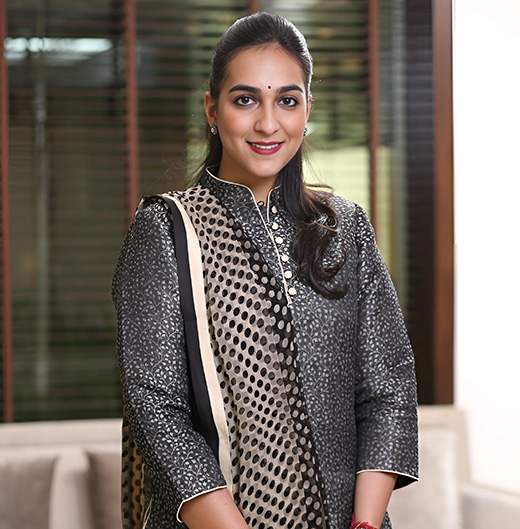
About Tara Singh Vachani
Copyright © 2024 India Leaders For Social Sector

